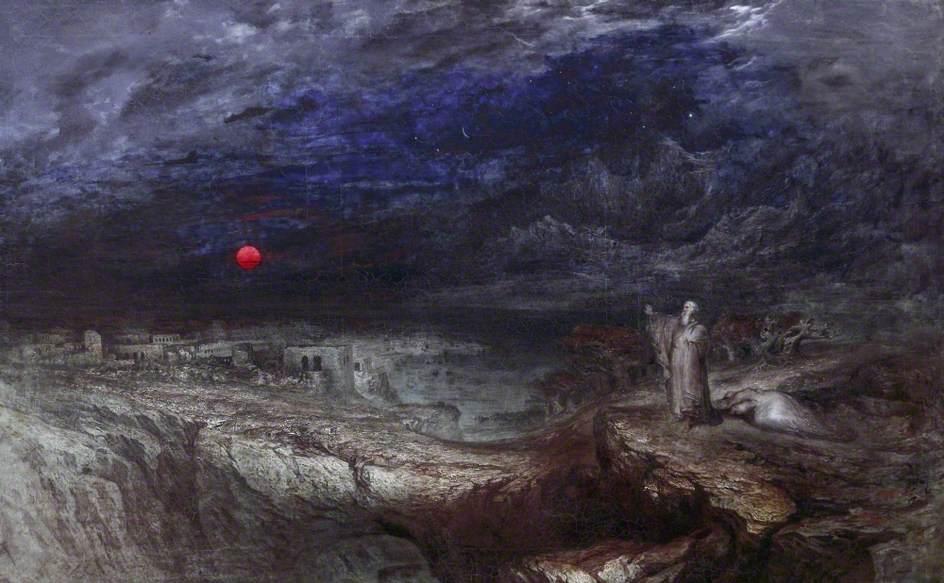
The long eighteenth century saw a sustained interest in all things apocalyptic. From doomsday cults to Christian eschatological poetry, the apocalypse was repeatedly framed in traditional, biblical terms whereby the end of the world would be marked by fire and brimstone, and then ultimately by God’s judgement of man. Towards the end of this period, however, the concept of secular apocalypse gained popularity, and with this came various imaginings of what the world - in a godless universe - would look like post-apocalypse.
For a generation of Romantic writers who held a deep fascination with the individual, the next logical step was to envisage a lone figure left alone on the post-apocalyptic earth: the Last Man. This theme was first explored in English by Lord Byron, who in 1816 published a short poem, ‘Darkness’, which imagined the death of the sun and the subsequent demise of humanity. By the end of the text, it is only the consciousness of the speaker - who functions as a Last Man figure - that remains in a dark and desolate universe.
It took several more years for the Last Man theme to achieve widespread popularity. In 1823, the respected poet Thomas Campbell wrote a short poem called ‘The Last Man’ in which a single survivor figure watches the death of the world, but this text was not widely discussed until it was republished in 1825. At this point, readers noted some similarities with ‘Darkness’ and Campbell was accused of copying Byron’s idea. Campbell passionately defended the originality of his work, and claimed that Byron had stolen the idea from him following a conversation between the pair some years before. Byron, having died in 1824, was unable to comment on the situation, and so the debate remained open as to who had come up with the first Last Man.
Campbell’s poem is probably the least bleak of all the Romantic Last Man texts, as it features a Last Man who remains confident that he has been chosen by God and will ‘live again’ after his earthly death. Having gained widespread notoriety due to the 1825 plagiarism scandal, the poem inspired a short operatic scene by William H. Callcott that was performed in 1826, 1827, 1828, and 1830 and was well received by critics. Campbell’s vision of the Last Man was also painted by John Martin in 1832 and by J. M. W. Turner in 1837.
The Last Man theme reached a peak in popularity in 1826 with the publication of a range of texts including the anonymous poems ‘The City of the Dead’ and ‘The Death of the World’; a Blackwood’s tale entitled ‘The Last Man’; a novel by Mary Shelley entitled The Last Man; and a satirical poem - also called ‘The Last Man’ - by Thomas Hood.
The irony of the existence of multiple ‘last’ men by this point was not lost on contemporary commentators. A writer for the London Magazine and Review - examining the dispute surrounding the originality of Campbell’s text - asked how Campbell could ‘submit, in short, to produce a last Last Man, when the first conception was his?’ [commentator’s emphasis]. Likewise, the Monthly Magazine carried an essay in 1826 about ‘Last Things in General’, which wryly noted that ‘we cannot close the doors of language on the thousand little beginnings that tread on the heels of the safest conclusion’.
In the coming years, a few more - largely derivative - Last Man texts were published. One of the final Romantic imaginings of the Last Man occurred in George Dibdin Pitt’s play The Last Man, or the Miser of Eltham Green, which was performed in 1833. In this comic play, an old man outlives the other members of his ‘Brothers’ Club’, and has a harrowing recurring dream that he is destined to be the Last Man on earth. Despite being surrounded by friends and family, Geoffrey dies having designated himself ‘THE LAST MAN’. His death marks the end of the Last Man theme in Romantic literature, and the figure of the Last Man did not become a popular concern again until the end of the nineteenth century.



